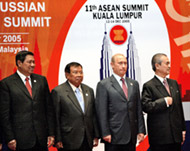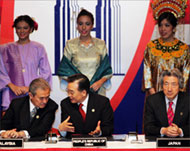E Asian summit papers over cracks
An inaugural East Asian summit has ended with an agreement to boost cooperation in the fight against bird flu, but with talks overshadowed by continuing frosty relations between China and Japan.

Held in the Malaysian city of Kuala Lumpur, the half-day meeting on Wednesday was hosted by the ten-member Association of South-East Asian Nations (Asean).
A joint declaration by the 16 heads of governments attending the inaugural East Asia Summit said they would make every effort to “enhance national, regional and international capacities” to prevent bird flu from transforming into a human pandemic.
They also agreed to improve “national policies for prevention and control of emerging infectious diseases in general”, the statement said.
As well as Asean leaders, the summit brought together the leaders of Japan, China, India, South Korea and Australia.
Core members
“We have all agreed that East Asian community will be a reality in the future,” Malaysian Prime Minister Abdullah Ahmad Badawi, who chaired the half-day talks, said.
 |
|
Russia is eager to join Asean and |
But Abdullah drew a distinction between what he regarded as the core members of an East Asian community – Southeast Asia and North Asia – and countries such as India, Australia and New Zealand, which he said did not belong geographically in East Asia.
“I don’t know how the Australians will regard themselves as East Asians, or New Zealanders for that matter,” he said, adding these countries instead shared common interests with East Asia.
Russia attended the meeting as an observer and is pushing to be a full member, although leaders failed to reach consensus on its admission.
Political wrangling
Russia is eager to meet more of Asia‘s thirst for oil and gas and sees the region taking up to a third of its exports by 2020.
Australia and Indonesia said before the summit that the group’s structure should be sorted out before admitting Russia.
“It was very historic” |
“I think what we should try and do is settle in the existing architecture,” Australian Prime Minister John Howard said.
Australia, a former British colony, is itself only just now making its own entry onto the centre-stage of Asian diplomacy, after plenty of debate in the region over its Asian credentials.
Japan is seen as favouring a greater role for newcomers India, Australia and New Zealand in the grouping, to balance out China‘s influence in the absence of the US. But Asean has made it clear it wants itself and North Asia in the driving seat.
Little substance
After the three and half hour summit, Philippine President Gloria Macapagal Arroyo said: “It was very historic.”
The summit ended with an agreement to meet every year rather than every two years, but with little else of substance aside from a pledge to cooperate in tackling the spread of bird flu.
 |
|
Indian PM Manmohan Singh |
India has been pushing hard for the group to agree on moves towards establishing a region wide free-trade area which adds up to a fifth of world trade.
The meeting of 16 heads of governments – representing more than half of humanity – was intended to chart the path towards building a pan-Asian community.
But with tensions between China and Japan simmering beneath the surface, that still seemed a distant goal.
The row between the two countries stumbled on to centre-stage earlier this week after Chinese and South Korean leaders called for Japan‘s Prime Minister Junichiro Koizumi to show a “proper attitude” over history.
The comment was in reference to Koizumi’s visits to Tokyo‘s Yasukuni shrine which honours Japan‘s 2.5 million war dead, including several convicted war criminals.
Divisive issue
The divisive issue goes to the heart of Japan‘s relations with China and South Korea, both of whom suffered heavily at the hands of imperial Japanese troops.
Ending the summit on Wednesday, China‘s Prime Minister Wen Jiabao begrudingly agreed to shake Koizumi’s hand, but he had earlier refused to hold one-to-one talks with the Japanese leader.
 |
|
China’s leader did not conceal his |
But Koizumi said: “I am ready to meet anytime. I have no hard feelings.”
He said he did not understand the criticism.
Chinese Prime Minister Wen Jiabao appeared to make clear his continuing displeasure with his Japanese counterpart Junichiro Koizumi when he ignored Koizumi’s request to borrow his pen at the signing ceremony.
Wen ignored Koizumi for several seconds until Badawi intervened to repeat the request.
Summit tension
Wen then passed the pen to Koizumi with a smile, but the incident was widely noted amid an otherwise uneventful ceremony that concluded the 16-nation summit’s formal business.
There was also summit tension over whether India, Australia and New Zealand would share the driving seat of an East Asian community or, in the words of an Indian diplomat, be passengers.
Asean comprises of Brunei, Cambodia, Indonesia, Laos, Malaysia, Myanmar, the Philippines, Singapore, Thailand and Vietnam.